Table of Contents
Introduction
- Concrete is a very strong and mouldable (comes in any shape) construction material.
- This can continue to harden and gains strength over many years.
- It has a very long history.
- The Ancient Romans weren’t the first to make concrete.
- Romans were first to utilize this material widespread around 600 BC.
- The Romans successfully implemented the use of concrete in the majority of their construction around 200 BC.
- It wasn’t until 1793 that this innovation took a major jump forward when John Smeaton found an increasingly present day technique for delivering water driven lime for concrete.
- In 1824 Joseph Aspdin designed Portland concrete by consuming finely ground chalk and dirt until the carbon dioxide was evacuated.
- After that the first widespread use of concrete in home construction was in England and France between 1850 and 1880 byFrancois Coignet.
- In the nineteenth Century, concrete was utilized for the most part for mechanical structures.
Definition of Concrete
- This is the most advance technology which is a mixture of cement, sand, pebbles or crushed rock and water that becomes hard like a stone after a specified days of curing.
Components of RCC Concrete
1. Cement
2. Fine Aggregates ( Sand )
3. Coarse Aggregates ( Pebbles )
4. Steel
5. Water
6. Admixture
1. Cement
- This is one of the major part of concrete which plays a binding work for whole the components.
- If you want to know more about Cement than touch my link Cement under:
2. Fine Aggregates ( Sand )
- Sand is a granular material made out of finely isolated stone and mineral particles.
3. Coarse Aggregates ( Pebbles )
- Coarse aggregates are construction component made of rock quarried from ground deposits.
4. Steel
- Steel is fundamentally an alloy of iron and carbon, with the the carbon content varying up to 1.5 %.
5. Water
- Water is abundant in nature which uses in construction work but free from natural impurities.
6. Admixture
- It is a type of chemical uses in concretes production to increase or decrease its setting time in the construction field.
- It only uses in the big construction work where transportation facility is far from pouring site.
- The use of this chemical is not in practice in smaller works like making home, etc.
Types of Concrete
1. Reinforced Cement Concrete
2. Plain Cement Concrete
3. Ready -mix Concretes
4. Light weight Concretes
5. Fiber reinforced Concrete
6. Green Concrete
1. Reinforced Cement Concretes ( R C C )

- It is the combination of ordinary concrete with the steel to increase its compressive and tensile strength to a great extent.
- Widely use of this in the construction field.
- It reduces the size of structure.
- Sizes reduce but load bearing capacity increases.
- So, Today’s world likes this most.
- It saves money due to reduce size of structure.
- In old age, due to no use of R C C, size of place increase and also takes wide area for making place.
- For example :-
a. Buildings
b. Flyover
c. Highways roads traffic
d. Hydro -power plants
e. Tunnels
f. Irrigation canals
g. Drains ,etc.
2. Plain Cement Concretes ( P C C )
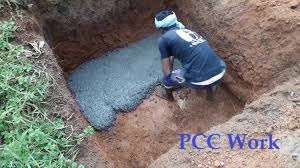
- It is the mixture of cement, fine aggregate, and coarse aggregate without steel.
- It is popularly known as P C C.
- Before starting any R C C work on ground, we first do P C C work to stop corrosion of steel.
- Save main structure from bacterial attack.
3. Ready -mix Concretes
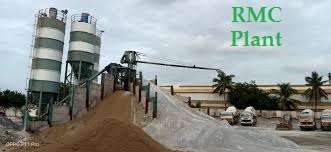
- It never prepares on the job site.
- This prepares at central plant on a fixed batch.
- It is fully machinery made mix.
- Making construction work of this is on huge scale.
4. Light weight Concretes
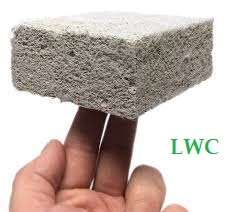
- It is a type of mixture that is made with a light weight coarse aggregate and five aggregate which may be light weight.
- It oftens used in house construction.
- Decrease in dead loads making reserve funds in establishments and fortification.
- Improved thermal properties.
- Improved fore resistances.
- Reduction in form work.
5. Fiber reinforced Concretes
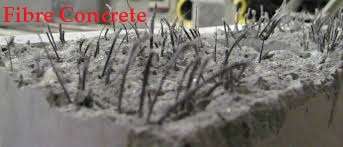
- It is a mixture of cement, mortar or concrete with suitable fibers.
- Increases the tensile strength of the concrete.
- Reduces the air voids & water voids.
- This increases the durability of the concrete.
- It’s compressive strength is not enough.
- It does not prefer for heavy structure.
6. Green Concretes
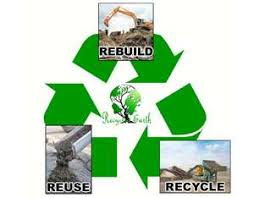
- The concrete is made with concretes wastes which are Eco – friendly so called as Green concrete.
- Better Performance
- Enhance cohesion work ability / consistency
- Reduce shrinkage / creep.
- Durability – Better service life of concretes
- Reduce carbon footprint
- Optimizes use of available materials
- No increase in cost
- LID India Certification
- If you want to know more about Green Concretes than touch my link Green Concretes under :-
Properties of Concrete
- High compressive strength.
- Free from corrosion and there is no appreciable effect of atmospheric agents on it.
- It solidifies with age and the way toward solidifying proceeds for quite a while.
- This proves more economical than steel.
- It binds rapidly with steel.
- This is weak in tension.
- Have a tendency to shrink.
- It has a tendency to be porous.
- It frames a hard surface, equipped for opposing scraped spot.
- When it is fresh, it should have enough workability so that it can place in the formwork easily.
- It must possess maximum density or in other words, it should be the strongest and the most watertight.
- The cost of materials and labor require to form the concretes should minimum.
Different Methods of Proportioning Concrete
- There are different methods as follows :-
1. Arbitrary Method
2. Fineness Modulus Method
3. Minimum Voids Method
4. Maximum Density Method
5. Water Cement Ratio Method
1. Arbitrary Method
- In this method, there is no rigid control on the strength of the concretes mix. However this method widely uses for all works of small magnitude because of its simplicity in the design.
- Known mixes of concrete is as under :-
| Proportion of Concrete Mix | Maximum size of Aggregate | Nature of Work |
| 1 : 1 : 2 | 12 – 20 mm | Heavily loaded RCC columns and Arches. |
| 1 : 2 : 2 | 12 – 20 mm | Small precast members. |
| 1 : 1.5 : 3 | 20 mm | Water retaining structures. |
| 1 : 2 : 3 or 1 : 3.66 : 3.33 | 20 mm | Water tank, bridge construction, etc. |
| 1 : 2.5 : 3.5 | 25 mm | Footpath and road work. |
| 1 : 2 : 4 | 40 mm | General RCC work. |
| 1 : 3 : 6 | 50 mm | Mass concreting work in culverts, etc. |
| 1: 4 : 8 or 1 : 5 : 10 or 1 : 6 : 12 | 60 mm | Heavy walls and foundation footings, etc. |
2. Fineness Modulus Method
- The term fineness modulus s uses to show a file number which is harsh corresponding to the normal size of the molecule in the whole amount of total.
- Let P be the designed fineness modulus for a concretes mix of fine and coarse aggregates.
Then
R = [( P2 – P ) / ( P – P1 ) ] × 100
Where
R = Proportion of fine total to the joined total by weight.
P1 = fineness modulus of fine aggregate.
P2 = fineness modulus of coarse aggregates.
3. Minimum Voids Method
- In this method, the voids of coarse aggregate and fine aggregate determine separately and to get the dense concrete, it is so arranged that :
a. The quantity of fine aggregate completely fills the voids of the coarse aggregate.
b. The quantity of cement completely fills the voids of the fine aggregate.
c. Sufficient water adds to the mix of cement, fine aggregate and coarse aggregate to make the mix workable.
4. Maximum Density Method
- This methods bases on the principle that the densest concretes achieves by proportioning its aggregates in such a manner that the heaviest weight of concrete for same volume obtains.
- This method of maximum density is not very popular mainly because of the following two reasons :
a. The grading can not accurately achieve.
b. There is no control over the strength of concretes.
5. Water Cement Ratio Method
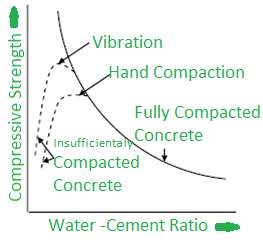
- As per water cement ratio law by Abram, the strength of well compact concretes with good workability depends only on the water cement ratio.
- By applying this law, concretes assumes to be fully compact.
- The lower water content produces stiff paste.
- Water cement ratio within certain limits results in the increase strength.
- Similarly the higher water content increases the workability but it is not useful for the chemical reaction.
- The excess water evaporates leaving pores in the concrete thus the increase water cement ratio lowers the strength of concretes.
Workability of Concrete
- Workability is the amount of work to produce full compaction.
- The important facts in connection with workability are :
1. If more water adds to attain the required degree of workmanship, it results into concretes of low strength and poor durability.
2. If the strength of concretes affects, the degree of workability can obtain.
- By slightlying changing the proportions of fine and coarse aggregates, in case the concretes mixture is too wet, and
- By adding a small quantity of water cement paste in the proportion of original mix, in case the concretes mixture is too dry.
3. The workability of concretes also affects by the maximum size of the coarse aggregates to use in the mixture.
4. The workability of concrete affects mainly by water content, water cement ratio and aggregate cement ratio.
Factors Affecting Workability
- Following are the elements which influence the usefulness of Concrete.
1. Water Content
2. Mix Proportions
3. Size of Aggregates
4. Shape of Aggregates
1. Water Content
- Water content of concretes have sufficient influence on the workability.
- The high the water content per cubic meter of cements, the higher will be the smoothness of cements which is one of the significant factor influencing usefulness.
2. Mix Proportions
- Total / Cement proportion is a significant factor impacting functionality.
- The higher aggregate -cement ratio as well as leaner is the concretes.
- In lean concretes, less quantity of paste is available for providing lubrication per unit surface area of aggregate and hence the mobility of aggregate restrains.
- In case of rich concretes with lower aggregate -cement ratio, more paste is available to make the mix cohesive and fatty to give better workability.
3. Size of Aggregates
- The bigger the size of the aggregate, lesser is the surface area and hence less amount of water requires for wetting the surface and less matrix of paste requires for lubricating the surface to reduce internal friction.
- For a given quantity of water and paste, bigger size of aggregates give higher workability.
4. Shape of Aggregates
- The shape of aggregates influences workability to a large extent.
- Angular, elongated or flaky aggregate makes the concretes very harsh when compare to round or cubical shape aggregates.
- Adjusted totals have less surface zone and less voids than rakish or flaky total, not just that, being round fit as a fiddle, the frictional obstruction is additionally extraordinarily diminished.
- Because of above reason, river sand and gravel provide greater workability to concretes than crushed aggregate and sand.
Concrete Tests
1. Slump Test
2. Flow Test
3. Vee -Bee Test
4. Compaction factor Test
5. Vee -Bee Consistometer Test
1. Slump Test

- It is the most generally utilized strategy for estimating consistency of cement.
- This test also tells about workability.
- It is not a suitable method for very wet or very dry concretes.
- It doesn’t measures all factors contributing to workability.
- The diameter of the rod is 16mm and its length is 60cm.
- The dimensions of Slump Test Apparatus is as under :
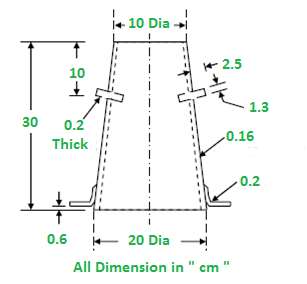
Advantages of Slump Test
- Easily detect the difference in water content of successive batches of concretes.
- The apparatus is cheep, portable and convenient to be used at site.
Limitations of Slump Test
- It occurs only in case of plastic mixes.
- It doesn’t occur in case of dry mixes.
- There is no immediate connection between the functionality and the estimation of droop.
- It is not suitable for a concrete in which maximum size of aggregates exceeds 40mm.
- There are chance of many shapes of slump to occur and it is difficult to decide which one is giving the correct value.
2. Flow Test
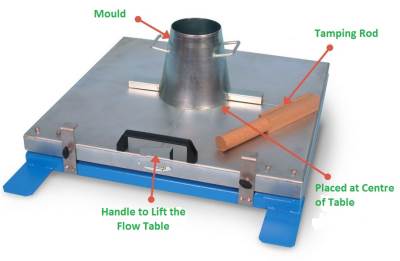
- This is a research center test which gives a sign of the nature of cement regarding consistency, cohesiveness and the inclination to isolation.
- In this test, a standard mass of cement is exposed to shocking.
- The dimensions of Flow Test Apparatus is as under :-
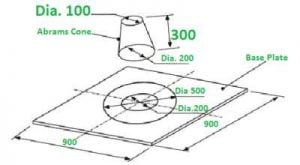
3. Vee -Bee Test
- This test is preferred for finding workability of stiff concretes mix having very low workability.
4. Compaction factor Test
- In this test, the degree of workability of concrete measures in terms of internal energy required to compact the concrete thoroughly.
- This test designs for the use in the laboratory but it can also use in the field.
- The degree of compaction calls the compacting factor which measures by the density ratio.
C. F = Wt. of partially compacted concrete / Wt. of fully compacted concrete
5. Vee -Bee Consistometer Test
- It is a good measure indirectly the workability of concretes.
- This test consist of a vibrating table, a metal pot and a standard iron rod.
Grade of Concrete
- Level of Concrete is characterized as the base quality of the solid must groups following 28 days of development with appropriate quality control.
- It is denoted by prefixing M.
- For example : M10, M15, M20, M25, M30, M35, etc. where M stands for Design mix and the numbers represents specified strength in N / mm² after 28 days of curing.
Concrete Mix Design
- When the task of deciding the proportion of the constituents of concretes decides by the use of certain relationships, the concretes thus produces terms as design mix concrete.
- Concrete Mix design procedure for a particular grade of concretes depends on the following requirements :
- Characteristic strength of concretes.
- Degree of workability.
- Specific gravity and bulk density of cement.
- Grading zone of fine aggregate and size of coarse aggregates.
- Specific gravity and bulk density of coarse and fine aggregates.
- Moisture content.
Steps for Concrete Mix Design is as follows :-
1. Target mean strength and standard deviation
2. Selection of water -cement ratio
3. Selection of water content
4. Calculation of cementations material content
5. Estimation of coarse aggregates
6. Estimation of mass of coarse aggregates
7. Correction for actual site conditions
Nominal Mix Concrete
- Nominal Mix Concrete is a concrete which uses where the quality control requirement for design mixes are difficult to implement.
Curing of Concrete
- Curing is a process of making concrete surface wet for a certain period of time so as to promote the hardening of cement.
- The curing period is about 7 – 14 or 28 days.
Purpose of Curing
- It protects the concretes surfaces from sun and wind.
- The strength of concretes increases with age when curing is efficient.
- By proper curing, the durability and impermeability of concretes increases and shrinkage reduces.
Effects of Improper Curing
- The rate of carbonation increases.
- Frost and weathering resistance decreases.
- The durability decreases due to higher permeability.
- Cracks are formed.
Methods of Curing
- Ponding with water.
- Covering concrete with wet jute bags.
- Covering concrete with water proof paper.
- Spraying with water.
- Continuous sprinkling of water.
- Applying curing compounds.
The best among all methods above is Ponding.
Precautions in Concrete Construction
Following Precaution should be observed :
- Concrete ought to be crisp and liberated from set concrete particles.
- Aggregates should be well graded and free from dirt, etc.
- Blending water ought to be liberated from unsafe synthetic compounds and remote materials.
- Prepared concrete each time should be used and finished within 30 minutes or initial setting time of cement.
- Concretes should prepare on rigid and water tight platform without loosing any cement or water.
- Complete blending of fixings either by hand or by blender ought to be guaranteed.
- Care should be taken to avoid bleeding and segregation during transporting or placing concrete.
- The form work on which concrete lay must check for its rigidity.
- Laid concrete must compact thoroughly by manual tamping or mechanical vibration.
- During bad weather conditions, precautions for concreting should be taken.
https://mechanicalnotes.com/cement-definition-introduction-types-composition-and-tests/ ←



WoW what a note about concrete sir
Good note sir
Thanks….